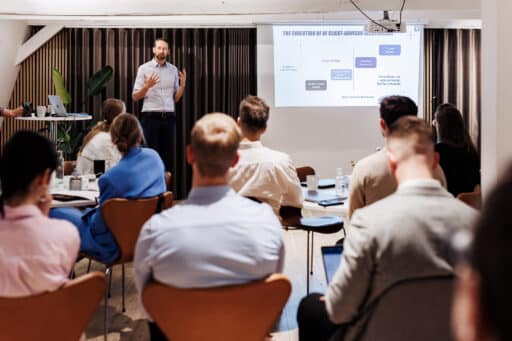3 basic approaches
The Leadership Pipeline is based on the fundamental question: What do I need to succeed in my leadership role and what does it require of me? There are three basic approaches to implementing the leadership pipeline: rings in the water, strategy implementation and total implementation. For all three approaches, the public Leadership Pipeline provides a framework for working to create shared images of how the leadership task can be understood and how organizations can work to "produce" leadership. In addition, they all build on the three basic assumptions of the leadership pipeline:
- The right leadership at the right level: What good leadership is depends on what is being led. A leadership framework has the function of clarifying the necessary skills, priorities and work values for each level of management. It provides the basis for guiding and aligning expectations so that the management chain is coherent from top to bottom.
- Every change in leadership level involves a transition: Transition is about learning, unlearning and retaining certain behaviors. Leadership development must address letting go, adding and retaining parts of your behavior in order to succeed in a new leadership function or leadership context.
- Leadership development is a management responsibility: Managers must take responsibility for supporting and developing their own managers. This means that managers can coach, provide feedback and create learning processes that are closely related to the task at hand. HR units must support the management organization in "producing" leadership quality and leadership talent by offering support tools for leadership development.
Let's take a closer look at the characteristics of the three approaches to working with the Leadership Pipeline.
Rings in the water
As the name of this approach suggests, you start by applying leadership pipeline thinking in a limited part of an overall organization - for example, in one department in a municipality. The approach can then spread like a ripple effect to other parts of the organization. To get started, top management and HR don't have to work to get buy-in from all parts of the organization. There's a huge amount of drive and momentum in the ripple effect approach for the simple reason that it consists of fewer players, who can therefore agree relatively quickly on what they want to do with the Public Leadership Pipeline thinking and which activities to include. It can be especially useful to choose the ripple-in-the-water approach if the decision-maker is unsure whether there is the will and support to work with the Leadership Pipeline throughout the organization.
Strategy implementation
The strategy implementation approach helps clarify the roles and responsibilities associated with new strategic benchmarks and agendas. In particular, it aims to strengthen a well-functioning organization with high strategy implementation power by mobilizing the entire management chain around the common strategic effort. The approach is therefore particularly relevant when there is a need to clarify how the individual management levels contribute best in realizing a strategic effort or course for the organization. It is important to ensure both horizontal and vertical coordination throughout the management organization.
Read more about our training
LEAD offers certification in the development of agile leadership with the development tool "Leader Versatility Index" (LVI)
With a certification, you will be equipped to use LVI in development processes in your organization at the individual, group and organizational level.
The total implementation approach
The total implementation approach is - as the name suggests - all-encompassing. It is on two parameters: First, the leadership foundation covers all the leadership roles in the total organization. Secondly, the organization's leadership support systems and development processes are designed and aligned specifically to elevate leaders in their leadership roles and behaviors.
The total implementation aims to create a common language, culture and practice of good leadership in the organization, based on clearer roles and responsibilities at each level. The approach reaches deep into the core business of the entire HR unit with recruitment processes, onboarding, leadership evaluation, the concept of LUS and MUS, and leadership development activities across the organization.
The total implementation approach thus consists of three steps (steps 2 and 3 often run in parallel):
- Development of common leadership profiles or leadership foundations
- Alignment of support structures and processes for the production of "good leadership"
- Design leadership development initiatives in the form of planned development programs as well as ongoing feedback and coaching on a daily basis from manager to manager and from manager to employee.
What leadership development activity actually looks like varies greatly. The key is that the aim is to sharpen managers' skills and self-awareness towards the defined roles and responsibilities.
Leadership profiles / leadership foundations are a good starting point for aligning expectations and for organizational support in succeeding with the requirements and expectations associated with each level.
If you embark on using the Leadership Pipeline - regardless of which of the three approaches described here - just remind yourself and each other that the answers to what good leadership is, after all, are a temporary clarification. This must be subject to continuous change and revision as the demands of the outside world on the organization evolve over time. But even the temporary clarification is useful and provides three benefits:
- Establishing a common language of leadership leverage for the work of creating stronger interaction both horizontally and vertically
- A more precise alignment of expectations about what is important to succeed in the job
- Strengthening each manager's awareness of their own role and co-responsibility for developing their own managers/employees.




